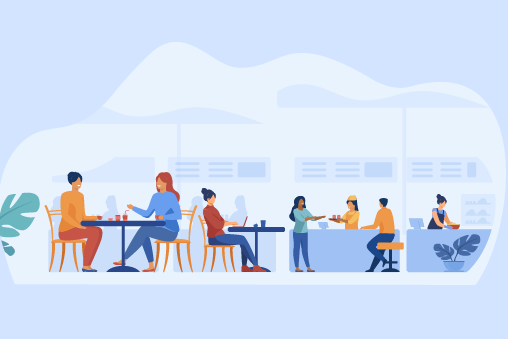How the corporate cafeteria changed
The cafeteria was once the hub of social activity and office interactions. In fact, the last few decades saw the shift from a utilitarian and simple company canteen to a plush, more experiential corporate cafeteria. They became the go-to place where employees came to unwind and take a break. Well-designed and well-equipped cafeterias were the pride of many companies, even playing a part in their recruitment.
But the advent of COVID-19, and the subsequent lockdowns, brought everything to a standstill. And when employees returned to campuses, instructions not to share food and social distancing saw the end of the cafeteria as the get-together spot. New protocols also encouraged contactless ordering, staggered timings, and more. And the most efficient way forward to deal with the changes was digitisation.
Digitisation and corporate F&B
While the adoption of cafeteria digitisation may have been accelerated by the pandemic, the benefits go far beyond adherence to protocols.
Streamlined operations and reduced costs
Cafeteria digitisation helps in streamlining operations across the board. From the company admin to the vendor partner to the end consumer, digitisation simplifies the process and makes it more efficient. It leads to added transparency, efficient tracking of orders and consumption, better planning, less waste, and less pilferage.
Improved employee experience
The upside of digitisation can be tangibly felt by the employee/consumer. The most obvious benefits are more choices, faster order fulfillment (with no time wasted waiting in queues), easy payment options, and even contactless ordering and vending. But that is not all. A comprehensive cafeteria digitisation solution puts the power in the hands of the consumer. The app enables ordering from anywhere, and for anywhere. Employees can even use the app in restaurants and associated vendors away from their company campus.
The experience need not be limited to food. HR or admin’s ability to set up payment rule options – fully paid by the company, part-paid by company, or reimbursement policies, for example – can help simplify the employee’s navigation of the perks ecosystem.
Data and engagement for the better
The biggest effect that digitisation has may not be immediately visible. By integrating all the systems and processes into one comprehensive solution, digitisation enables the gathering of business intelligence that can transform the way corporate F&B operates.
Employees have an easy engagement platform to share feedback and give suggestions. Vendors have visibility into inputs and final orders, and they have the ability to track trends and use predictive analysis for efficient resource planning. Corporate admin gets real-time data that can govern decisions that meet the best interests of all stakeholders.
The future of corporate F&B is digitised solutions
The F&B industry has been undergoing changes for decades now. But the pandemic has pushed these changes into transformation overdrive. Cafeteria digitisation solutions that were beginning to take hold pre-2020 have now become de rigueur in forward-looking organisations worldwide. Smart companies that have productivity, efficiency, cost reduction, and a great employee food experience in mind will not hesitate to embrace this movement.

